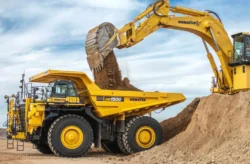Construction sites rarely look calm: grinders whine, trucks unload, and saws slice through timber. Amid the commotion, airborne hazards quietly build up, drifting through corridors and settling in unsuspecting lungs. By identifying the most common contaminants and understanding how they arise, supervisors and crew members can adopt smarter controls and preserve long-term respiratory health, rather than reacting to illness after it strikes.
Dust and Particulate Matter
From demolishing plaster walls to dumping sacks of dry cement, dust is the pollutant crews see first—and often shrug off. Large chips irritate eyes, but the weightless fraction floats for hours and slips deep into bronchioles where it fans inflammation, worsens asthma, and accelerates chronic obstructive lung disease.
Controlling it starts with disciplined housekeeping: vacuum sweepers instead of dry brooms, debris chutes kept damp, and power tools fitted with shrouded extraction. Add disposable P2 masks as a final barrier, and every exhale feels lighter.
Chemical Fumes and Vapors
Paints, sealants, and solvent-based adhesives may look harmless in the can, yet once applied, they release volatile organic compounds that displace oxygen and sting mucous membranes. In closed rooms, such vapors bring headaches, dizziness, or even chemical pneumonia by the end of a shift.
Prevention hinges on product choice and airflow: low-VOC formulas, lids snapped tight between uses, fans pushing fresh air in, and ducted blowers dragging contaminants out. When tasks demand stronger solvents, half-mask respirators with correct cartridges keep brains clear and noses happy.
Silica and Asbestos Fibers
Crystalline silica is locked inside concrete, brick, and engineered stone. Break the surface with a saw or drill, and razor-fine shards billow out like smoke. Once inhaled, they slice lung tissue, forming scar tissue that stiffens breathing and can mature into silicosis or lung cancer.
Older sites add the wildcard of asbestos, whose fibers behave similarly but remain airborne even longer. Wet-cutting blades, negative-pressure enclosures, and mandatory fit-tested respirators create a layered defense that keeps these stealthy minerals off the jobsite punch list.
Welding Smoke and Metal Aerosols
Welding arcs vaporize base metal, flux, and any surface coating, cooling into an ultrafine fume loaded with iron, manganese, chromium, and nickel. Because these particles measure less than a micron, they bypass nasal filters and embed in alveolar sacs, provoking metal fume fever today and neurological disorders tomorrow.
The best countermeasures are local extraction hoods placed close to the bead and steady cross-draft ventilation that sweeps residual smoke away. To seal the deal, workers should don appropriate respiratory protection gear before striking the first arc.
Conclusion
Even the most dazzling new build is not worth a tradesperson’s lungs. When managers treat air quality with the same urgency as load limits or lockout tags, teams thrive and schedules stay intact. Recognising dust, chemical vapors, fibrous minerals, and welding aerosols as predictable by-products—not unpredictable accidents—makes controls second nature.
Put air first, and every hammer blow, torch pass, and paint stroke lands safer. Healthy lungs also mean fewer sick days, lower compensation claims, and a workforce that can focus on craftsmanship instead of coughing fits.







